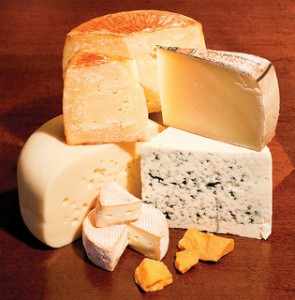
Photo courtesy of UW-Madison College of Agricultural and Life Sciences
Mark Stephenson, Extension Dairy Policy Analyst
Department of Agricultural and Applied Economics
UW-Madison College of Agricultural and Life Sciences
mwstephenson@wisc.edu
(608) 890-3755
NOTE: Part 2 of 2 podcasts discussing Wisconsin’s dairy industry. Part 1 can be found at https://fyi.extension.wisc.edu/news/2020/01/10/wi-dairy-overview-2019-and-2020/
Total Time – 5:16
00:00 – Dairy means more than milk
00:33 – Ag-related businesses and the processing sector
01:31 – Dean/Borden bankruptcy impact on WI dairy/underlying reasons for bankruptcy
02:56 – Consumers’ tastes and preferences changing
03:30 – Need for food science research
04:27 – New dairy products
05:09 – Lead out
TRANSCRIPT
Lorre Kolb: Looking at the various ways dairy contributes to Wisconsin’s economy. We’re talking with Mark Stephenson, Extension Dairy Policy Analyst at UW-Madison and I’m Lorre Kolb. Earlier this year, a report came out that dairy contributes about 45 billion to Wisconsin’s industrial revenues. Stephenson said dairy means more than milk.
Mark Stephenson: It’s not just milk. It’s what we make from the milk, the cheese, how much employment that engenders and what the sales are for those products.
Lorre Kolb: It’s not just the dairy products themselves that contribute to the economy, but it’s the ag-related businesses as well.
Mark Stephenson: Absolutely, it’s input suppliers. We tend to focus at the farm. Right. That’s what we think about. How is it for dairy producers? But on both ends of that, you know, you have contributions to the economy. It’s the feed suppliers. It’s the veterinarians, it’s the consultants, it’s the milk haulers. It’s a variety of things that are, you know, leading up to the farm gate. And then after the farm gate, of course, you’ve got the processing. And honestly, when we look at the kind of study that was done that looks at the, economic multipliers, the big multipliers for the state’s dairy industry really come a lot from the processing sector. So processors, of course, couldn’t process dairy products if they didn’t have milk. Milk is a very important part of that. But, you know, it’s not just farms alone.
Lorre Kolb: We saw Dean and Borden’s file for bankruptcy, how will this impact Wisconsin dairy producers?
Mark Stephenson: I don’t think it will impact Wisconsin dairy producers very much. Part of the reason is that we only have one Dean plant in this state, although we do have several that are down on our southern border. And certainly Wisconsin milk goes to those plants. But it’s not that those plants are going away, it’s that Dean Foods and Borden are now under reorganization. So they’re continuing to process milk and to buy milk and pay for it. But I think the real question is probably what underlies the reason for those bankruptcies? And we have to really talk about the health of the entire milk supply chain being fluid. Milk has been under assault here since about 2010. Well, we’ve maybe longer than that, but 2010 has been very noticeable. And that comes from not just plant based beverages, which a lot of people want to kind of blame for this, but it’s also other beverages like water. Water’s probably a bigger competitor with milk than the plant based beverages have been. But we have other things going on, too. We’re fighting demographics. Children are the biggest consumer of beverage milk and we’re having fewer children in this country. So that segment is not moving as rapidly.
Lorre Kolb: Stephenson says we’re also seeing consumers’ tastes and preferences change.
Mark Stephenson: A good example is milk is a companion to cold cereal and cold cereal sales have just been in the tank as well. We wake up in the morning, we don’t eat cold cereal. When I was a kid, we had cold cereal every morning for breakfast. And I can’t tell you the last time I had a bowl of cold cereal. But I do get up in the morning and I’ll grab a carton of yogurt instead. So I’ve shifted categories, I’m still eating dairy, but I’m eating it. I’m not drinking it.
Lorre Kolb: So there’s a need for more food science research to find different products that milk products can be used in?
Mark Stephenson: I think that’s absolutely true. I mean, fluid milk consumption is a concern for the dairy industry. It should be. We ought to look at that. We should see whether or not there are modifications to the product that can be made that would entice consumers to look at it again. However, you know, I think that we also need to be aware that we’ve got to meet the consumer where they are if they want to change and consume something different. Let’s make sure we find a way to put dairy in that category. And if you look at the entire consumption of milk and all dairy products, that is not a sad story. It’s a good story. Last year, we hit the highest per capita consumption of milk equivalent in this country since the 1960s. So we’ve been growing milk consumption, just not in fluid milk.
Lorre Kolb: So we’ve seen a rise in artisanal cheeses, yogurts, other products, sports based products.
Mark Stephenson: Absolutely. I mean, and these are some of these things like sports based products are nothing we might think about traditionally for dairy and even specialty cheeses. You know, if you go back to the mid-1980s and this state produced commodity, cheeses for the most part made a conscientious shift into specialty cheeses and that met the consumer where they were going. So the consumer wanted different tastes and textures and profiles in their cheese. And we were there to supply it to them. We’re a very large supplier of specialty cheese now.
Lorre Kolb: We’ve been talking today with Mark Stephenson Extension Dairy Policy Analyst at UW-Madison and I’m Lorre Kolb.



